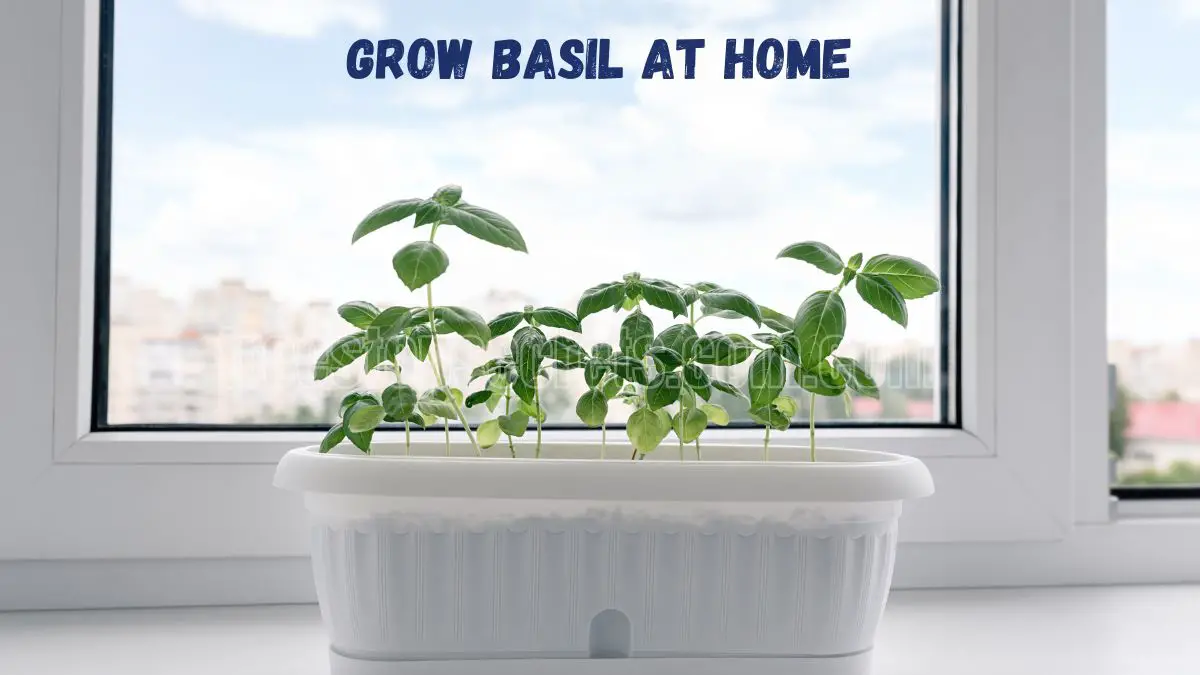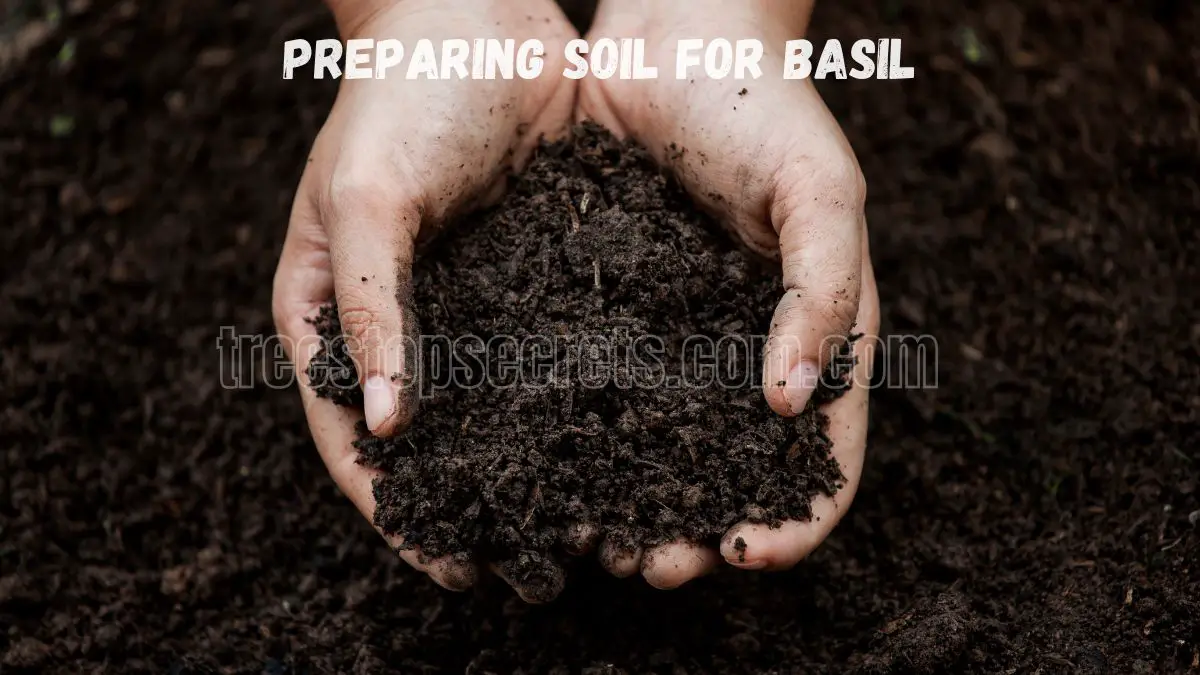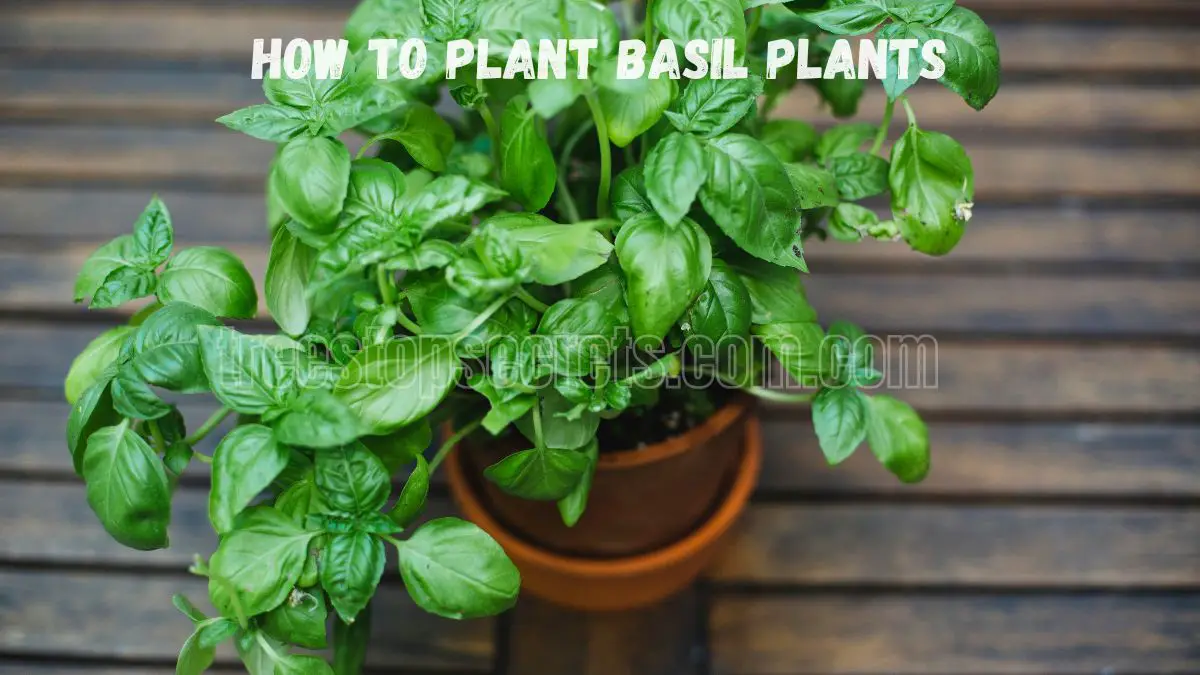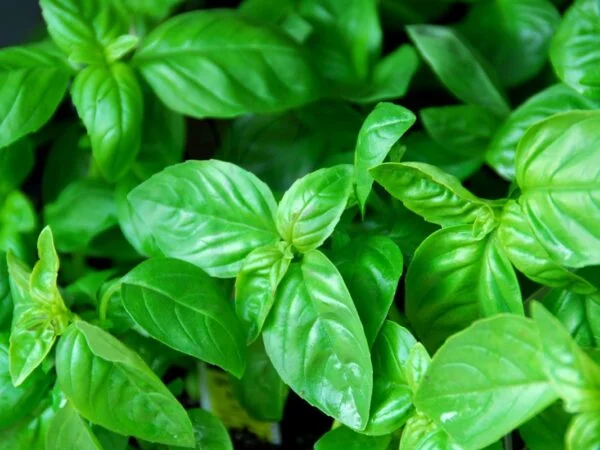Key Takeaways
- Growing basil at home will take the flavor of your dishes to the next level. Plus, it saves you money on store bought herbs! Begin with the goal of planting an array of basil types so you can discover which ones feel right for your cuisine.
- This is how to plant your basil plants from seed or transplant. Or, you can direct-seed them in the garden after all danger of frost has passed. Stagger your plantings once or twice for a continuous harvest all summer long.
- Plant basil in loose, well-draining, loamy soil with a pH level between 6.0 and 7.0, July through September. Add valuable organic matter such as compost to improve your soil.
- While planting, make sure to space your basil plants adequately so they can get proper air circulation around them and develop strong roots. This may mean planting them with a spacing of 12 to 18 inches between them.
- Give your basil consistent, deep watering without overdoing it. Yellowing leaves are a sure sign of overwatering, so keep an eye on your plants!
- Cut your basil stems back to 6 – 8 inches to ensure great flavor and optimal harvest of your plants. Prune the right way to get thicker basil plants! Learn how to store your harvested basil if you want it to stick around for a bit longer.
Learning how to grow basil plants is easy and truly rewarding! Basil does best in warm temperatures, so it’s a great choice for an in-ground garden bed or container on your patio or deck.
Start with seed or seedlings that are not old. Choose a spot that soaks up sun for at least 6-8 hours a day. Try to avoid compacted soil by using a light, well-draining mix and keeping it moist—not soggy.
Frequent harvesting of the leaves makes for bushier growth, and you can begin harvesting as soon as a few weeks after planting. With minimal maintenance, you’ll soon be enjoying culinary masterpieces all made with fresh basil.
In this post, I’ll walk you through the process of successfully planting basil plants to ensure a bountiful harvest. You’ll find its exquisite flavor in your kitchen all summer long!
Why Grow Basil at Home?

This versatile and popular herb is a great gardener-friendly choice that’s simple to grow, perfect for herb, vegetable or container gardens. Basil grows super fast—it grows so well that it usually doesn’t even need fertilization—with only 6 to 8 hours of sunlight a day.
You’ll have a healthy harvest of fresh basil in just 3 to 4 weeks. This rapid cultivation process makes it simple for you to get all of its delicious flavors!
1. Benefits of Homegrown Basil
The best reason to grow basil at home is the explosion of fresh flavor that will elevate all your favorite dishes. There’s nothing like freshly harvested basil leaves to brighten up savory dishes, from classic Italian caprese salad to summer cookout spreads.
You can try new varieties of basil that aren’t available at your grocery store. Sign up now! This is a rare opportunity to take your culinary skills to the next level!
Caring for these lively plants provides a deeply satisfying experience. You’ll come away with practical gardening skills and know-how, growing and caring for your plants, then harvesting—and eating!—the fruits of your labor.
2. Types of Basil Varieties to Consider
‘Genovese’ basil is the star of Italian cuisine; it’s perfect for sauces and pesto. For something different, try ‘Cinnamon’ basil, which imparts spicy flavor and wonderfully fragrant oils to baked goods and herbal teas.
Finally, ‘Thai’ basil fits well into Asian cuisine due to its sweet flavor, enriching stir-fries and curries. With all of these options available to you, growing basil at home gives you the chance to experiment and experience a variety of flavors.
Optimal Timing for Planting Basil
Timing is everything when it comes to planting basil seeds. By understanding your local climate, you’ll be able to more accurately determine the best planting window for your basil seedlings to thrive and maximize delicious leaves.
1. Best Seasons for Basil Planting
In short, spring is the best time to plant basil outdoors. Under warmer summer conditions, the exposed seed will germinate quickly and provide fast establishment.
Plant basil every few weeks to have it available all summer long. To have fresh basil to use from early summer until fall, just sow seeds every few weeks for consecutive harvests.
2. Regional Climate Considerations
Whether you’ll be growing indoors or outdoors, planting times depend on where you live. If you live in more northern regions such as zones 3a and 4a, start your seeds indoors between April 1 and 15.
Then, transplant them outdoors in mid to late May. For zones 5a and 5b, start seeds indoors from March 1-15 and transplant outdoors after April 15.
Understanding your region’s first and last frost dates is important since basil prefers temps to stay above 50°F all the time. Monitor humidity as well. Basil thrives in moderate humidity, making it important to monitor these levels for healthy growth.
3. Indoor vs Outdoor Planting Times
If you live in a particularly cool climate, beginning with basil indoors can give you a jump on the growing season. After your last frost, trap your seedlings with these tips.
Indoors, artificials, like grow lights, can both mimic that sunlight and sustain strong basil growth until it’s time to move your plants outdoors.
Preparing Soil for Basil

To ensure your basil seedlings grow strong and healthy, it's important to start with the proper soil, which directly influences the growth of young plants, taste, and overall production of delicious leaves. Here’s how to prepare your soil for thriving basil.
1. Ideal Soil Type and pH Level
Basil grows best in loamy soil with a pH between 6.0 and 7.0. This is because this range encourages nutrient absorption and healthy plant growth. Proper drainage is extremely important as it promotes healthy, deep root systems and avoids unnecessary water trapped in the soil that could produce root rot.
You need something that holds enough moisture for your growing basil but does not drown the root systems. If you’re growing in-ground, dig in 3 inches of compost-enriched Miracle-Gro Performance Organics All Purpose In-Ground Soil. Mix it thoroughly into the upper 6 inches of your current soil.
2. Soil Amendments for Nutrient-Rich Growth
Improve soil fertility by incorporating compost, which will help provide the nutrients basil needs to thrive. Organic fertilizers can help soil health and encourage healthy plant growth. You might think about adding worm castings, which make a great natural nutrient source.
In raised beds, you can use a mix of 50% in-ground soil with 50% container mix. Or try Miracle-Gro Performance Organics Raised Bed Mix for proven, balanced nutrition.
3. Techniques for Soil Preparation
To create a lighter soil, minimal tillage helps improve aeration and root penetration. Incorporating amendments fully makes for a consistent growing medium and ensures that nutrients and moisture are mixed uniformly.
Finally, rake the soil surface to create a smooth, level planting bed to encourage uniform watering and drainage. For container gardening, fill containers with Miracle-Gro Performance Organics All Purpose Container Mix. This aerated mix is moisture retentive and ideal for successful basil production.
Planting Techniques for Basil
Planting basil can be a fun and fruitful undertaking, so it’s important to select the best technique to ensure the success of your outdoor garden. You can begin with basil seeds or basil seedlings, based on your preference and gardening style. Whatever method you choose, each has its benefits, and knowing the ins and outs of each will set your basil up for success.
1. Starting Basil from Seeds Indoors
To start, pack seed flat with damp potting mix. Plant them fairly shallow, to a depth of around ¼ inch. A warm environment is especially important for germination, so make sure to keep them in a space that hovers around 70°F.
After the seeds germinate, be sure that they are getting enough light—grow lights can help grow vigorous, sturdy seedlings.
2. Transplanting Seedlings Outdoors
To prepare your seedlings for their new life outdoors, harden them off by slowly introducing them to outside conditions over the course of a week. If you are using transplants, set them out 12 to 18 inches apart so they will have air circulation around them.
Once planted in the ground, water deeply to encourage roots to become established.
3. Direct Sowing Methods
If you’d rather direct sow, hold off until after the last frost date.
Soil PreparationPlan to plant basil plants in rich, well-drained beds with lots of sunlight—at least six hours daily. Be sure to water regularly to keep the soil evenly moist during germination.
4. Spacing and Potting Considerations
To give them room to grow, plant your basil plants 12 to 18 inches apart. If you practice container gardening, use the largest pots possible that allow roots space to develop.
Be sure these pots have drainage holes to avoid water collecting at the bottom.
Light and Temperature Requirements
For thriving, abundant basil to enjoy all summer long, it’s important to know their light and temperature requirements. Basil thrives in hot, bright environments – just like me! Just make sure you put your plants somewhere that will provide them full sun — at least six hours a day.
Whether growing basil inside or out, the more light basil gets, the bigger and tastier the leaves will be.
1. Understanding Basil's Light Needs
Basil needs full sun to thrive. If you’re attempting to grow basil indoors, your lights will have to do the work of replacing or supplementing the sun. Look for grow lights with a full spectrum or those specifically designed for the photosynthesis process.
Regularly rotating your pots can be beneficial. It ensures that every side of the plant receives equal light, promoting balanced growth. Just this one easy step can keep your plants from getting leggy and promote fuller, bushier growth.
2. Ideal Temperature Ranges for Growth
Keeping their temperature at the proper levels is equally critical. For best growth, plan for daytime temperatures in the range of 70°F to 90°F. If you’re in a cooler climate, wait to plant your basil until later.
Planting outdoors, wait until after your last expected frost date to make sure it’s taken care of. It is important to keep watch on nighttime temperatures, keeping it above 50°F, since cooler nights can slow growth.
When extreme heat hits, provide your basil with some afternoon shade to protect it from frying. That added protection makes all the difference on the hottest of days!
Watering and Fertilizing Basil
Consistent watering and fertilizing practices are key to having happy healthy basil plants. Set up a regular watering routine to help maintain soil moisture without overdoing it. Deep watering helps establish strong root growth so the plants can reach down to where nutrients are stored.
Check Soil Moisture Before WateringWater basil plant soil the same way you do any other plant. This eliminates the dangers of overwatering, which can become deadly to your plants. A watering wand can be helpful in this situation—you can water gently on top of things without disturbing your freshly sown soil.
1. Best Practices for Watering Basil
Water basil plants in the cool part of the day, either early morning or late afternoon. This timing helps reduce evaporation, saving water and ensuring your plants stay strong. When you do water, provide about an inch of water per week, give or take depending on your weather.
Add a layer of mulch at the base of the plant to help conserve moisture and make watering less frequent. This protects sensitive roots, keeps the soil temperature more even, and provides a more uniform environment for growth.
2. Organic Fertilization Techniques
Consistent fertilization counterbalances any minerals removed from the growing medium when the robust green leaves are harvested regularly. Organic fertilizers are the best choice for promoting vigorous, leafy plants with robust flavor.
Select slow-release fertilizers such as compost or well-composted manure to feed the plants gradually. When plants are growing vigorously, you may want to use liquid fertilizers that are readily absorbed by the plant. Combined, these two practices go a long way toward keeping your basil healthy and tasty.
3. Signs of Overwatering and Underwatering
Overwatering will cause the leaves to yellow, and sometimes underwatering can make them wilt or droop. Keep a close eye on your plants so you can tailor your watering habits to keep them healthy.
All this meticulous care will result in a robust basil crop that you can enjoy.
Ongoing Care for Healthy Growth
To raise healthy basil plants, including popular varieties like sweet basil and lemon basil, regular care and maintenance, along with pest management scouting, is essential.
1. Regular Maintenance Tips
Basil should be pruned to produce a bushier plant and to prevent flowering, which can compromise flavor. Remove the top most leaves every few weeks to encourage more growth of side stems.
Preventing pest and disease issues on your basil involves regular pruning, like removing dead or yellowing leaves, which invite pest and disease problems that can spread quickly. A healthy growing environment is just as essential.
Remove debris or overwintering leaves to eliminate pest attractions.
2. Pest and Disease Management Strategies
Monitor your basil regularly for pests such as aphids and slugs. With early detection, you can act fast.
You may discover some pests, but before you reach for synthetic pesticides, try gentle organic solutions like insecticidal soap or neem oil which are safer, effective and backyard friendly.
Proper air circulation around your plants will go a long way to keeping potential fungal diseases at bay and helping your basil stay healthy and bright.
3. Companion Planting Benefits
Companion planting increases healthy growth and adds new flavor. Combining basil with tomatoes not only enhances the flavor but keeps harmful insects away.
Basil grows very well in partnership with peppers, helping both establish vigorous and healthy growth. Learn about compatible herbs and vegetables, and design a garden that will thrive with this beneficial garden ecosystem.
Harvesting Basil Leaves
Knowing when to harvest basil seedlings and how to do it the right way will help you keep your young basil plants healthy and flavorful for many months to come. Learning to properly harvest the delicious leaves and store them will take your culinary herbs experience to the next level.
1. When to Harvest for Maximum Flavor
For maximum flavor, let your basil plants grow to 6-8 inches tall before you start harvesting. This height tells you the plant is mature enough to offer some hearty flavors.
Because basil leaves bruise easily, harvesting in the morning is your best option. At that point, the oils responsible for basil’s distinctive scent and taste are at their most potent.
By consistently harvesting leaves you’re able to enjoy fresh herbs while encouraging the basil plant to grow more leaves. Plus it stops bolting, or flowering, which can alter its flavor altogether.
2. Proper Harvesting Techniques
To harvest basil leaves, always pinch or cut them off to prevent pulling and shocking your plant. A helpful harvesting practice is to prune stems a few inches above a leaf node.
This technique encourages bushier growth by forcing new branches to grow. Just be careful not to harvest more than a third of the plant in a single harvest.
This practice will keep the plant healthy and capable of producing for the rest of the growing season.
3. Storing Fresh Basil Leaves
For temporary storage, place fresh basil in a vase of water on the countertop. This technique has the added benefit of ensuring the leaves will remain bright and fresh.
For long-term storage, think about freezing basil leaves in ice trays loaded with extra virgin olive oil, which maintain the flavor.
You could dry basil leaves to enjoy this great herb all year round in your cooking.
Common Mistakes to Avoid
Planting basil can be a rewarding journey, especially when you start with basil seeds or seedlings. Learning to avoid common pitfalls is crucial for thriving basil plants, ensuring effective watering methods, adequate plant spacing, and appropriate lighting conditions.
1. First-Time Planting Errors
Use caution when practicing soil preparation. Skipping this step can result in chronic drainage issues and nutrient deficiency. High-quality soil with good aeration and organic matter content is vital for healthy growth.
Poor management of seedlings shortly after germination can slow further establishment. Water seedlings regularly for consistent moisture, not soggy soil, and keep them covered from opportunistic pests.
No matter how great your soil prep or transplanting technique, hardening off your seedlings before transplanting is key. Gradually expose them to outdoor conditions over a week to help them adapt.
2. Misunderstanding Basil's Needs
Basil really loves it warm and sunny, without any swings in temperature. Shoot for a minimum of six hours of direct sun each day, because when plants don’t get enough light they can get leggy.
Plants require regular pruning to thrive in their given locations. Harvest by snipping off the top leaves often to promote bushy growth and delay bolting, which changes the taste.
Look out for indications of distress, like yellowing foliage or droop. Resolve these situations promptly by changing water/light levels.
Conclusion
There’s nothing like growing your own basil to add bright, fresh flavor to your cooking and fragrant beauty to your garden. In exchange, you get a reliable herb that makes your cooking and your room a whole lot better. Timing, soil, and care are all essential ingredients to your success. Once mastered, you can look forward to bountiful basil plants. Consistent watering and quality light will go a long way in keeping your plants vibrant and thriving. When it’s finally time to harvest, you’ll love the smugness of tossing those homegrown basil leaves into your cooking. Steer clear of these common blunders, and you’ll be doing yourself a favor by reaping a treasure trove of mouthwatering flavor. Explore basil growing magic with us today and all summer long. So roll up your sleeves and get back to planting and weeding this time, savoring the fruits of your labor. Your culinary adventures will be completely transformed!
Frequently Asked Questions
How much sunlight does basil need?
Basil, particularly common basil and its favorite varieties like sweet basil, thrives in full sun, requiring 6-8 hours of direct sunlight daily for bushy growth and fragrant leaves.
What type of soil is best for basil?
Grow basil seedlings in rich, well-drained soils with a pH of 6.0 to 7.0. A combination of potting soil and compost does a great job of keeping young basil plants healthy and flourishing.
How often should I water basil plants?
Water your basil seedlings when the top inch of the soil is dry to the touch. Usually, this translates to watering every 3-5 days, but it all depends on your specific temperature and humidity levels.
Can basil be grown indoors?
Yes, basil seedlings do quite well when grown indoors with plenty of light, either natural or artificial. If necessary, provide your young basil plants with at least 6-8 hours of light each day to help them thrive.
When is the best time to harvest basil?
Once your basil seedlings reach a healthy height of 6-8 inches, typically 4-6 weeks after planting basil seeds, you’ll want to start harvesting the delicious leaves to encourage bushier growth.
What pests commonly affect basil plants?
Common pests like aphids, spider mites, and whiteflies can affect basil seedlings; monitor plants closely and treat with insecticidal soap or neem oil.
Can I grow basil from cuttings?
Yes, it’s possible to propagate basil seedlings from cuttings. Place the cuttings in water until roots are established, then move the young basil plants to soil for healthy new adults.
Image Source: Paid image from CANVA



